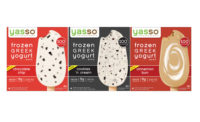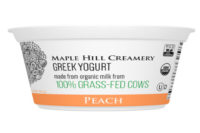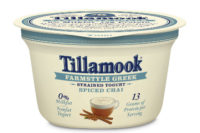South central Wisconsin has a long tradition of cheesemaking. Green County was settled by the Swiss who farmed in the rolling hills and made cheese from the milk of their dairy cows. The region celebrates its heritage with annual cheese-tasting fundraisers and festivals.
About two dozen cheese processing or cut-and-wrap plants operate in Green County, according to a state directory. The county seat, Monroe, calls itself the “Specialty Cheese Capital of the USA.” It might want to amend that title; it now counts a processor of Greek yogurt among its ranks.
In March, Klondike Cheese Co. began producing Greek yogurt in an addition it built to its cheese production facility. It also makes nearly 30 million pounds of cheese annually. Most of the production is feta cheese; Muenster and Havarti account for the remainder. And, like any good cheesemaker, it processes whey by-products into WPC 34, whey cream and lactose (concentrated to 27%).
Yogurt production
At-A-Glance |
|
Klondike Cheese Co., Monroe, Wis. Interstate Milk Shipper plant 48 (97% enforcement rating, April 2013) Size of plant: 180,000 square feet Employees: 100 production; 115 total Number of shifts: 2 Products made: Feta, Muenster, Havarti cheeses; Greek yogurt; WPC 34, whey cream and lactose Brands: Odyssey (feta and Greek yogurt); plus private label and co-packing accounts Food safety certification: British Retail Consortium USDA grading service approvals (April 2013): Brick, Muenster, milk Silos: Four 20,000-gallon silos (for yogurt); three 60,000-gallon and one 50,000-gallon (for feta); two 40,000-gallon and one 20,000 (other cheeses) Pasteurization: HT/ST Cheesemaking equipment: One coagulator (for feta); four 40,000-gallon double-O vats (Muenster, Havarti) To see more photos of this plant, visit behind the scenes! |
Klondike was putting the finishing touches on its yogurt production facility when Dairy Foods visited in early April. It invested $12 million to build the addition to its cheesemaking plant and to purchase processing equipment. The yogurt area includes separate rooms for fermentation, filling and palletizing.
The company makes Greek yogurt for branded, private-label and foodservice accounts. Its own brand is called Odyssey (as is its feta cheese). The dairy processor packages 5.3-ounce containers for grocery store customers; 1-, 2-, 4- and 5-pound packages for foodservice and club store customers; and 55-gallon drums for accounts that use Greek yogurt as an ingredient in processed foods.
The plant has separate silos for the milk used for cheese and yogurt products. There are four 20,000-gallon silos for yogurt; four for feta (three 60,000-gallon and one 50,000-gallon) and three for the other cheeses (two 40,000-gallon and one 20,000).
Ron Buholzer, one of three brothers who own the company, said this was their first experience with making a Grade A product. They needed to learn and understand the nuances of Grade A production, compared to cheesemaking.
His nephew, Adam Buholzer, the vice president of production, noted that “yogurt is less forgiving than cheese.” Changes in temperature or cultures will affect flavor and thickness, he said. Making yogurt seems “simple,” he said. It’s just fermenting milk and packaging it, but there are “lots of details” in production, he added.
Klondike receives milk daily from local farms. There are dedicated silos for yogurt and for cheese. Raw milk and finished product are tested in an on-site lab. Finished products are also sent to the Foreign Type Cheese Association, a co-operative lab in Monroe, for testing.
There is no federal standard of identity for Greek yogurt, so manufacturers can produce it any number of ways. But consumers expect higher protein levels than found in conventional yogurt, and they want a thicker and creamier mouthfeel.
Some processors strain excess whey from the white mass to concentrate protein levels in the finished product. Another way to boost protein is to add milk protein concentrate. That is what Klondike does. It’s a process they learned from Evangelos Mandrekaes, a processor who makes Greek yogurt in Greece and who advised the Buholzer family.
Phillip S. Tong, a professor of dairy science at California Polytechnic State University (and a Dairy Foodscolumnist), said a key advantage of the “no-whey-separation” approach is that the yogurt can be either cup set or bulk set. Also, calcium and other constituents of milk are retained since there is no drainage.
Writing in the May Dairy Foods, Tong states “there really is no simple answer to what is ‘best’” when it comes to manufacturing Greek yogurt. “There are pros and cons to all the approaches in producing higher-protein yogurts.”
Greek yogurt purists can push their point of view all day long, but without a standard of identity of the product, they’ll never win the argument.
Klondike’s approach was also driven by environmental reasons, said Adam Buholzer, the vice president of production. It avoids the creation of acid whey, which needs to be treated before disposal.
Klondike’s four fermentation tanks have a capacity of 1,000 gallons each. There are two buffer tanks, which act like balancing tanks, explained Luke Buholzer, vice president of sales. Fluid milk, fortified by the milk protein concentrate, is pasteurized by the HT/ST process. The milk flows through a homogenizer to the fermentation tanks where cultures are added.
The white mass is pumped from the fermentation tanks to a filling room. There is a bulk filler for barrels, a 5-gallon pail filler and a three-lane filler that packages 5.3-ounce cups and containers ranging in weight from 1 pound to 5 pounds (for club store accounts). An air handling system with a HEPA filter in the filling room contributes to a sterile environment.
Klondike produces a blended yogurt in vanilla and fruit flavors. Depending on the customer, yogurt packages are sealed with foil or film. The packages are then conveyed to the packaging room when they are put in cartons. Palletized loads are shrink-wrapped and forklifts move them to a warehouse.
Cheese made by masters
The biggest part of Klondike’s production is cheese. It makes an estimated 8 million pounds of Muenster and 20 million pounds of feta annually. The company counts four master cheesemakers in its ranks. All are certified in feta, two in Muenster and one in brick. The master cheesemakers are brothers Ron, Dave and Steve Buholzer, and Jim Demeter. Adam Buholzer is enrolled in the master program. He’s worked on low-fat and fat-free feta and on Havarti.
A big selling point for Klondike is its consistency in cheesemaking, said marketing manager Teena Buholzer, Adam’s wife. Customers know that batch after batch, year after year, the cheese will taste and look like previous purchases. The company’s emphasis on good manufacturing processes and food safety also helps retain customers and gain new business. The plant participates in the Global Food Safety Initiative and has passed three consecutive annual British Retail Consortium audits of the production of regular, fat-free, low-fat, organic and kosher cheeses.
Automated production of feta
In 2001, Klondike built an addition for the production of feta cheese. It has its own brand (Odyssey) and makes feta (including an organic version) for private-label accounts. Unlike the Muenster production, which is very hands-on, feta is produced in a continuous, automated process. One machine operator oversees the production line, which is about 60 yards long.
The coagulator is essentially a moving trough with dividers that form individual cells. Each cell is filled with 1,800 pounds of milk (as measured by a flow meter). After a cell is formed and filled with milk containing the starter culture, it begins to move down the line and another divider is added to create a new cell. It takes about one hour for a cell to travel the length of the line.
At various stages, lipase enzyme and calcium are added and rennet is dosed and mixed into the milk by an agitator. In time, the mass takes on the consistency of Jell-O. Just before cutting the curd, the divider at the front of the cell is removed robotically. (It moves through a wash tunnel and back to the head of the line.)
Two blades cut the curd in two directions (cross cut and longitudinally). This process separates the whey from the cheese mass. (Whey is pumped to the whey processing room.) The curd begins to heal and then moves, by gravity, to the block former. After forming, the blocks are stacked and conveyed to a drain room. A 55-pound block is drained to 20 pounds.
After removal from the forms, the cheese slabs (also called loaves) are placed in brine for 24 hours. Cheese destined to be cubed is cut first and then brined because it is more brittle. Brined slabs then pass through a metal detector on their way to packaging.
Klondike has various packaging lines. Four lines make retail cuts. Slabs are cut into thirds (each weighing about 6 pounds). Feta for foodservice accounts is packaged in 9-pound or 20-pound pails. The pails are filled, lidded, labeled and code-dated.
Cubed cheese goes through a crumbler, and the crumbles are dowsed with potato starch. The crumbles are conveyed to a weigh scale which fills 6-ounce cups. The containers are sealed with film and an overcap is added. The cups are passed through a metal detector one more time and then are labeled, code-dated and checkweighed. A robotic cartoner photographs the lid and the label. The robot builds multipack cases which are palletized and conveyed to the warehouse. A barcode to the customer’s specs is applied.
Making Muenster
Making Muenster and Havarti is less automated than feta production and more hands-on. The plant has four 40,000-gallon double-O vats that cut, cook and stir the pasteurized milk, cultures and rennet. The curd is pumped from the vats into molds on a cheesemaking table. The molds are turned by hand four times in the space of two hours. This keeps a flat surface on each loaf, Luke Buholzer explained. In addition to using traditional rectangular molds, Klondike makes Muenster in round molds for the Hispanic market.
The loaves are then removed by hand and placed in a brining tank filled with cool well water. After an overnight brining, the loaves are removed from the tanks and pass through an annatto sprayer which coats all sides with the traditional orange color. Then 10 loaves at a time enter a vacuum sealer. Upon exiting this machine, they pass through a metal detector and a code-date is sprayed on the package. Labels are applied by hand and loaves are packed in cases and sent to the warehouse.
In 2011, Klondike participated in the Wisconsin Manufacturing Extension Partnership’s Profitable Sustainability Initiative to reduce costs and environmental impact. WMEP is a nonprofit consulting organization that helps small- to medium-size businesses. Auditors from the group first conduct structured interviews and make a cursory diagnostic evaluation of a business, said Rick Ray, a senior manufacturing specialist. In a second phase, the auditors and business owners undertake a “lean and clean” review to identify projects that can reduce environmental impacts. The real value of the audit is in this assessment phase, Ray said. Companies will identify projects they had not previously thought of, he said. Grants from the state of Wisconsin are used to fund projects.
After its audit, Klondike decided to move some of its cut-and-wrap operations back in-house. The move reduced fuel use and pollution from transportation, and it cut product delivery time by 70%. Klondike used a PSI grant to purchase packaging equipment. The $150,000 investment yielded $75,000 annual savings in costs related to shipping, saved 1,600 gallons of diesel fuel and reduced CO2 emissions by 16 metric tons. The cheesemaker also hired four full-time employees.
Ron, Dave and Steve Buholzer are the grandchildren of the man who started the business, which now employs the fourth generation of Buholzers. Asked what his grandfather would think of the changes to the company over the last 90 years and the new products Klondike is producing, Ron Buholzer said he would be proud of the awards the company has won. “He wanted to make the best cheese.”











